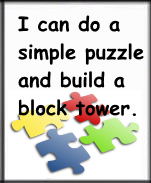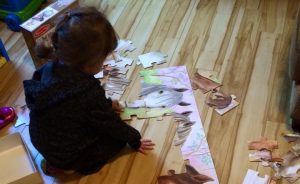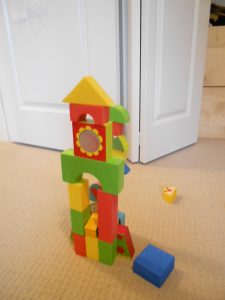Are you wondering how the item: children’s independent play with toys can be a ‘requirement’ for kindergarten? How kids play gives developmental clues. Play on the outside reflects what’s happening inside physically, mentally, and emotionally.

Let’s watch kids playing with puzzles. When kids first start playing with puzzles, they need large pieces made of wood, foam, or thick cardboard. The spaces where the pieces fit are obvious and simple shapes. As kids get older and have opportunities to play with puzzles, the pieces can be more numerous, smaller, and trickier. We can see the learning that’s taken place from the play.
During puzzle play, we can see evidence of how kids solve problems. Some kids will try one piece over and over, all different ways. Others will match the picture and colors. Hopefully, kids will use a few different strategies. This shows flexible thinking. We can see how a child deals with frustration. Does the child give up on the puzzle or persevere? Kids will make choices about the play. Is finishing the puzzle an important goal or does the child make a different choice? Maybe, a child will ask for help. There is so much more than just eye-hand coordination to get pieces of a puzzle together.

Generally, at the pre-kindergarten stage, kids can do a puzzle of about 7 or more pieces. This varies depending on previous play with puzzles and other toys but even with only a few pieces we can see physical, mental, and emotional development.
Blocks are a common toy and most kids have had a chance to play with some kind of construction block. Building a tower to see how high it can be before it falls over is another play activity that reveals a great deal of information. For example, does a child try more than once to build a higher tower after the blocks have fallen down? Watching how a child makes adjustments again shows problem-solving skills.

A child’s reaction when the tower falls is also important. Is the child easily frustrated or keeps trying? Of course, the noise and crash as the tower falls and rolls all over is pretty loud. For some this is exciting although other children may cover their ears. If more than one child plays with the blocks, we can also watch the interaction. A tower of 6 to 7 blocks is a guideline for this age.
Blocks and puzzles are only two common toys. Not only are there different toys, there are various levels of play. Just because kindergarten happens in school, doesn’t mean it’s only about academics. It’s also about how kids get along, how they interact with materials and information, and how they coordinate their own bodies. We don’t have to wait until kindergarten to gather clues about development. Children’s independent play with toys from just a few months old tells us so much about them and how they are learning. After all, isn’t play the brain’s favorite way to learn?
There are more items on the infographic Before I Go to Kindergarten. Check out the earlier and later posts too.
